
Condottieri were Italian captains in command of mercenary companies during the Middle Ages and of multinational armies during the early modern period. They notably served popes and other European monarchs during the Italian Wars of the Renaissance and the European Wars of Religion. Notable condottieri include Prospero Colonna, Giovanni dalle Bande Nere, Cesare Borgia, the Marquis of Pescara, Andrea Doria, and the Duke of Parma.
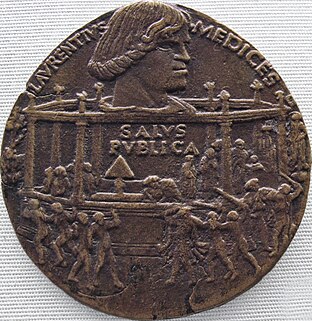
The Pazzi conspiracy was a plot by members of the Pazzi family and others to displace the Medici family as rulers of Renaissance Florence.
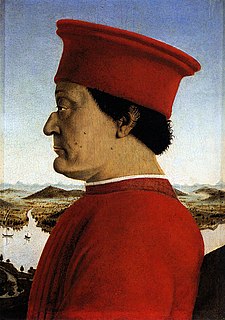
Federico da Montefeltro, also known as Federico III da Montefeltro KG, was one of the most successful mercenary captains (condottieri) of the Italian Renaissance, and lord of Urbino from 1444 until his death. A renowned intellectual humanist and civil leader in Urbino on top of his impeccable reputation for martial skill and honor, he commissioned the construction of a great library, perhaps the largest of Italy after the Vatican, with his own team of scribes in his scriptorium, and assembled around him a large humanistic court in the Ducal Palace, Urbino, designed by Luciano Laurana and Francesco di Giorgio Martini.

Sigismondo Pandolfo Malatesta was an Italian condottiero and nobleman, a member of the House of Malatesta and lord of Rimini and Fano from 1432. He was widely considered by his contemporaries as one of the most daring military leaders in Italy and commanded the Venetian forces in the 1465 campaign against the Ottoman Empire. He was also a poet and patron of the arts.

Braccio da Montone, born Andrea Fortebraccio, was an Italian condottiero.

The Battle of Campaldino was a battle between the Guelphs and Ghibellines on 11 June 1289. Mixed bands of pro-papal Guelf forces of Florence and allies, Pistoia, Lucca, Siena, and Prato, all loosely commanded by the paid condottiero Amerigo di Narbona with his own professional following, met a Ghibelline force from Arezzo including the perhaps reluctant bishop, Guglielmino degli Ubertini, in the plain of Campaldino, which leads from Pratovecchio to Poppi, part of the Tuscan countryside along the upper Arno called the Casentino. One of the combatants on the Guelph side was Dante Alighieri, twenty-four years old at the time.

The Battle of Montaperti was fought on 4 September 1260 between Florence and Siena in Tuscany as part of the conflict between the Guelphs and Ghibellines. The Florentines were routed. It was the bloodiest battle fought in Medieval Italy, with more than 10,000 fatalities. An act of treachery during the battle is recorded by Dante Alighieri in the Inferno section of the Divine Comedy.

Alberico da Barbiano was the first of the Italian condottieri. His master in military matters was the English mercenary John Hawkwood, known in Italy as Giovanni Acuto. Alberico's compagnia fought under the banner of Saint George, as the compagnia San Giorgio.

The Catholic Church in San Marino is part of the worldwide Catholic Church, under the leadership of the Pope in Rome.
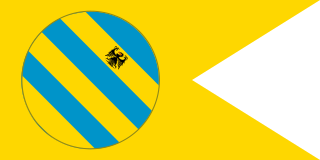
The Duchy of Urbino was an independent duchy in early modern central Italy, corresponding to the northern half of the modern region of Marche. It was directly annexed by the Papal States in 1625.
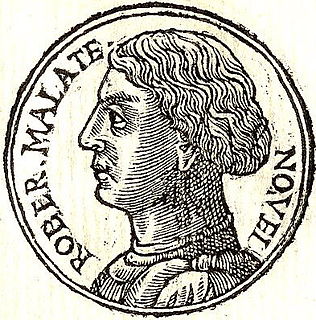
Roberto Malatesta was an Italian condottiero, or mercenary captain, lord of Rimini, and a member of the House of Malatesta.
The Great Company was a group of mercenaries, chiefly of German origin but operating in the Italian peninsula, who flourished in the mid-14th century. At its height, the company numbered approximately 10,000-12,000 men, chiefly armored cavalry. The Great Company's power set the pattern for later condottieri who came to dominate Renaissance Italian warfare.
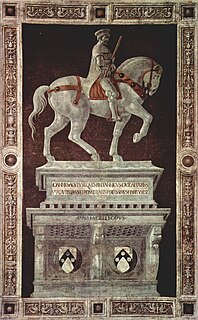
The Funerary Monumentto SirJohn Hawkwood is a fresco by Paolo Uccello, commemorating English condottiero John Hawkwood, commissioned in 1436 for Florence Cathedral. The fresco is an important example of art commemorating a soldier-for-hire who fought in the Italian peninsula and is a seminal work in the development of perspective.

A free company was an army of mercenaries between the 12th and 14th centuries recruited by private employers during wars. They acted independently of any government, and were thus "free". They regularly made a living by plunder when they were not employed; in France they were the routiers and écorcheurs who operated outside the highly structured law of arms. The term "free company" is most applied to those companies of soldiers which formed after the Peace of Brétigny during the Hundred Years' War and were active mainly in France, but it has been applied to other companies, such as the Catalan Company and companies that operated elsewhere, such as in Italy and the Holy Roman Empire.
Andrea Malatesta was an Italian condottiero, a member of the Malatesta family of Romagna. He is also known as Malatesta da Cesena, a city he had inherited in 1385 from his father, Galeotto, together with Cervia and Bertinoro. In 1388 he was also recognized lord of Fossombrone.
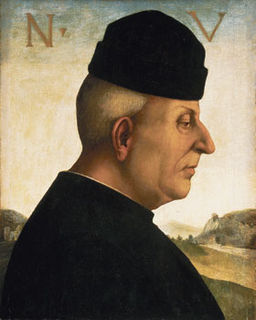
Niccolò Vitelli (1414–1486) was an Italian condottiero of the Vitelli family from Città di Castello.
The Compagnia di San Giorgio was the name of several companies of mercenaries in Italy during the 14th century.
The Battle of Portomaggiore took place near Portomaggiore in the province of Ferrara, Italy on 16 April 1395. It was fought between the Este troops of the Ferrara Regency Council fighting in the name of the young Niccolò III d'Este, Marquis of Ferrara and the rebel forces of his uncle, Azzo X d'Este, pretender to the Lordship of Ferrara.
Konrad Wirtinger von Landau, known in Italy as Conte Lando, was a German military adventurer and condottiero who was active in north and central Italy.













